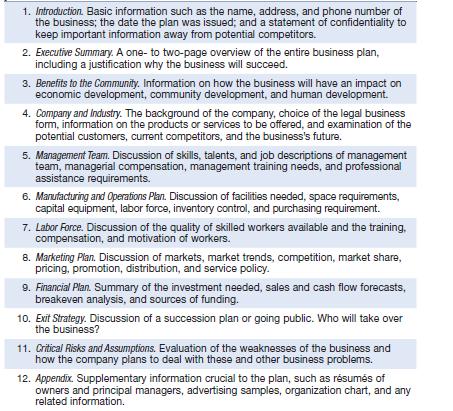Question:
A business plan is a written statement that documents the nature of a business and how that business intends to achieve its goals. Although entrepreneurs should prepare a business plan before starting a business, the plan also serves as an effective guide later on. The plan should concisely describe the business’s mission, the amount of capital it requires, its target market, competition, resources, production plan, marketing plan, organizational plan, assessment of risk, and financial plan.
Assignment
1. Working in a team of four students, identify a company in your community that would benefit from using a business plan, or create a scenario in which a hypothetical entrepreneur wants to start a business.
2. Using the resources of the library or the internet and/or interviews with business owners, write a business plan incorporating the information in Table 5-3.
3. Present your business plan to the class.
Table 5-3

Transcribed Image Text:
1. Introduction. Basic information such as the name, address, and phone number of the business; the date the plan was issued; and a statement of confidentiality to keep important information away from potential competitors. 2. Executive Summary. A one-to two-page overview of the entire business plan, including a justification why the business will succeed. 3. Benefits to the Community. Information on how the business will have an impact on economic development, community development, and human development. 4. Company and Industry. The background of the company, choice of the legal business form, information on the products or services to be offered, and examination of the potential customers, current competitors, and the business's future. 5. Management Team. Discussion of skills, talents, and job descriptions of management team, managerial compensation, management training needs, and professional assistance requirements. 6. Manufacturing and Operations Plan. Discussion of facilities needed, space requirements, capital equipment, labor force, inventory control, and purchasing requirement. 7. Labor Force. Discussion of the quality of skilled workers available and the training, compensation, and motivation of workers. 8. Marketing Plan. Discussion of markets, market trends, competition, market share, pricing, promotion, distribution, and service policy. 9. Financial Plan. Summary of the investment needed, sales and cash flow forecasts, breakeven analysis, and sources of funding. 10. Exit Strategy. Discussion of a succession plan or going public. Who will take over the business? 11. Critical Risks and Assumptions. Evaluation of the weaknesses of the business and how the company plans to deal with these and other business problems. 12. Appendix. Supplementary information crucial to the plan, such as rsums of owners and principal managers, advertising samples, organization chart, and any related information.







